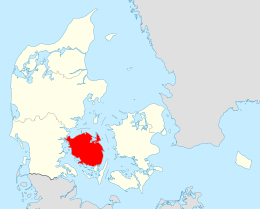 Global Information
Global InformationFunen information
Native name: Fyn | |
|---|---|
 A Sentinel-2 satellite image of the island | |
 | |
| Geography | |
| Location | Kattegat |
| Coordinates | 55°21′N 10°21′E / 55.350°N 10.350°E |
| Area | 2,984.56 km2 (1,152.35 sq mi) |
| Administration | |
Denmark | |
| Region | South Denmark Region |
| Municipality | Several |
| Largest settlement | Odense (pop. 180,302) |
| Demographics | |
| Population | 469,947 (2020) |
| Pop. density | 150/km2 (390/sq mi) |
Funen (Danish: Fyn, pronounced [ˈfyˀn]), with an area of 3,099.7 square kilometres (1,196.8 sq mi), is the third-largest island of Denmark, after Zealand and Vendsyssel-Thy. It is the 165th-largest island in the world. It is located in the central part of the country and has a population of 469,947 as of 2020.[1] Fyn's main city is Odense, which is connected to the sea by a seldom-used canal. The city's shipyard, Odense Steel Shipyard, has been relocated outside Odense proper.
Fyn belongs administratively to the Region of Southern Denmark. From 1970 to 2006 the island formed the biggest part of Funen County, which also included the islands of Langeland, Ærø, Tåsinge, and a number of smaller islands.

Fyn is linked to Zealand, Denmark's largest island, by the Great Belt Bridge, which carries both trains and cars. The bridge is in reality three bridges; low road and rail bridges connect Fyn to the small island of Sprogø in the middle of the Great Belt, and a long road suspension bridge (the second longest in the world at the time of opening) connects Funen the rest of the way to Zealand, paralleled by a rail tunnel.
Two bridges connect fyn to the Danish mainland, Jutland. The Old Little Belt Bridge was constructed in the 1930s, shortly before World War II, for both cars and trains. The New Little Belt Bridge, a suspension bridge, was constructed in the 1970s and is used for cars only.
The populations of the major cities and towns on the island are, as of 1 January 2018:[2]
- Odense: 178,210
- Svendborg: 27,324
- Nyborg: 17,164
- Middelfart: 15,246
- Fåborg: 7,065
- Assens: 6,209
- Kerteminde: 5,914
- Ringe: 5,912
- Otterup: 5,227
- Bogense: 3,891
Fyn was the birthplace of Hans Christian Andersen, the composer Carl Nielsen, American War of Independence combatant Christian Febiger, pop singer MØ and international footballer Christian Eriksen.
The highest natural point on fyn is Frøbjerg Bavnehøj.
- ^ "Kommuner på landkortet - Danmarks Statistik". Archived from the original on 23 March 2013. Retrieved 3 May 2013.
- ^ "Statistikbanken". statbank.dk. Retrieved 27 September 2018.